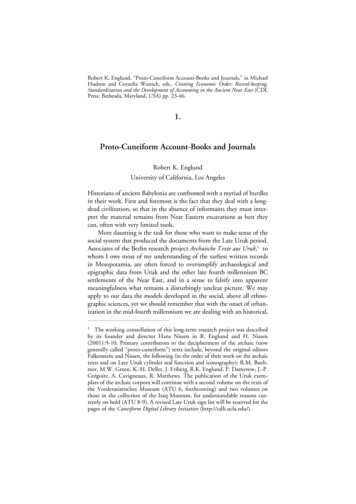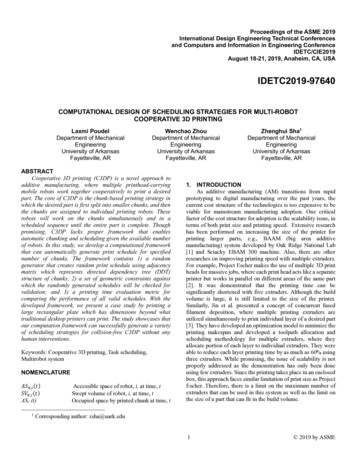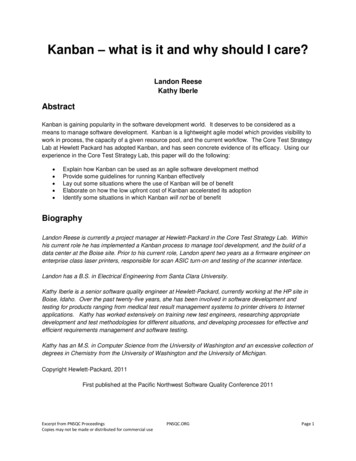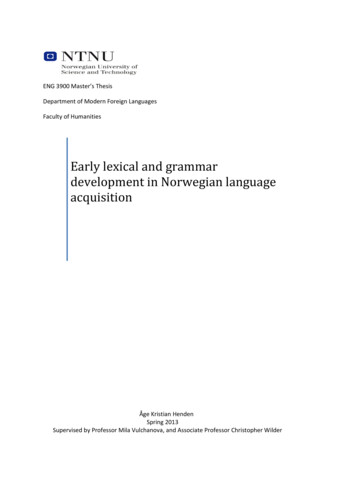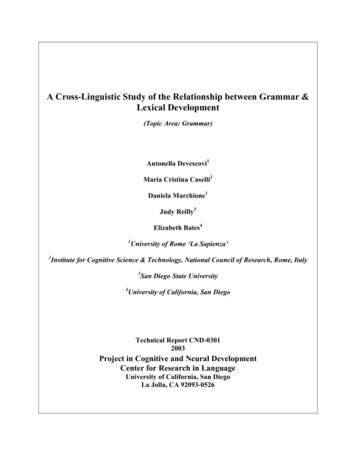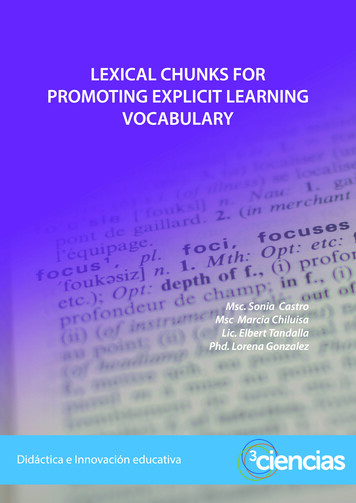
Transcription
PORTADA
LEXICAL CHUNKS FORPROMOTING EXPLICIT LEARNINGVOCABULARYMsc. Sonia CastroMagister en Docencia Universitaria y Administración Educativa, Docente de la UniversidadTécnica de Cotopaxi, Investigo en áreas de la enseñanza del idioma inglés.Msc. Marcia ChiluisaMagister en Docencia Universitaria y Administración Educativa, Docente de la UniversidadTécnica de Cotopaxi, Investigo en áreas de la enseñanza del idioma inglés.Lic. Elbert TandallaLicenciado en Inglés, Docente de la Universidad Técnica de Cotopaxi, Investigo enáreas de la enseñanza del idioma inglés.Phd. Lorena GonzalezDoctora en Pedagogía, PhD., Magister en Docencia Universitaria y AdministraciónEducativa, Docente de la Universidad Técnica de Cotopaxi, Investigo en áreas deciencias de la educación y la enseñanza del idioma inglés.
Editorial Área de Innovación y Desarrollo,S.L.Quedan todos los derechos reservados. Esta publicación no puede ser reproducida, distribuida,comunicada públicamente o utilizada, total o parcialmente, sin previa autorización. del texto: los autoresÁREA DE INNOVACIÓN Y DESARROLLO, S.L.C/ Els Alzamora, 17 - 03802 - ALCOY (ALICANTE) info@3ciencias.comPrimera edición: mayo 2018ISBN: 978-84-948882-3-6DOI: http://dx.doi.org/10.17993/DideInnEdu.2018.36
ÍNDICEINTRODUCTION 7PROJECT RATIONALE 9Beneficiaries of the project 9Research problem 9Objectives 10General Objective 10Specific Objectives 10Specific objectives, activities and methodology 11Scientific and technical foundations 11Lexical chunks 11Classification of lexical chunks 12Functions of lexical chunks 13Lexical chunks and language teaching 14Lexical chunks and language output 15Explicit learning 15Explicit vocabulary in reading comprehension 15Explicit vocabulary acquisition 16Explicit language learning 16Explicit instruction 16Sixteen elements of explicit instruction 17Reading skill 19Teaching reading 19Reading Explicit 19Use the word in context and give contextual information 20Reading through Short-stories 20Importance of vocabulary 21Types of vocabulary 21Scientific questions 22Methodology 22ANALYSIS AND DISCUSSION OF THE SURVEYS APPLIED TO STUDENTS AT “SEMILLASDE VIDA” EDUCATIVE UNIT 23ANALYSIS OF INTERVIEW APPLIED TO THE ENGLISH TEACHER AREA 31IMPACT 33CONCLUSIONS AND RECOMMENDATIONS 35Conclusion 35Recommendation 35ANNEXES 37BIBLIOGRAPHIC REFERENCES 41
Msc. Sonia Castro et al.INTRODUCTIONTeaching and learning process in the English language is important because it allowsstudents and teachers to improve listening, speaking, writing and reading skills inorder to understand activities that are in English. The problem that aboard thisresearch involves that students have lack of vocabulary for understanding writtenparagraphs in the English language, causing lack of understanding words and simplephrases from the English book. For this reason, the principal aim of this research isto determine the explicit learning vocabulary with lexical chunks through a literaturereview to promote vocabulary learning in students. To analyse the problem, it isnecessary to know why students have lack of vocabulary to learn English Language.It determined that the teacher unknown the lexical chunks as a strategy for teachingexplicit vocabulary to fortify comprehension in short written paragraph in English.This research project are done by phases: Phase 1, is the problem statement in orderto determine the current situation of causes and effects. Phase 2, the researchertries about theoretical foundation, it was based on different theories such as explicitlearning, vocabulary and lexical chunks. Phase 3, it was done in reference to theresearch methodology. It was used a descriptive method and surveys as a technicwhich was applied to the students and the interview to the teacher. Phase 4, it wasmade analysis and discussion of results in order to know preferences by students, itwas represented by statistics graphic and finally phases 5, it was done the conclusionsand the recommendations according to the framework and analysis and discussionof results.7
Lexical chunks for promoting explicit learning vocabulary8
Msc. Sonia Castro et al.PROJECT RATIONALEThis research project is done by the necessity to students to acquire vocabulary toimprove their comprehension reading skill because they have lack of vocabularyfor understanding written paragraphs in the English language, causing lack ofunderstanding words and simple phrases from the English book. Moreover, it isessential in L2 (Second Language) because it permits to understand written texts inEnglish. That is why, this research is important because it helps in the acquisition ofstudent’s vocabulary which facilitates to understand phrases, messages and shorttexts.Using lexical chunks would help acquire explicit learning vocabulary which meansstudents would be aware about what they learn in class. Therefore, with thiscombination the teacher can use short-stories or short readings that have lexicalchunks. Through it, teachers would promote the explicit learning in students.Additionally, this data would be useful for teachers who want to teach vocabularyin another way. Besides, this would help to improve reading skills and have a bettercomprehension at the moment to read messages, phrases or short texts in English.Beneficiaries of the projectThe direct beneficiaries of the present research project are “Semillas de Vida”Educative Unit. There are 7 students in this group, between 12 and 13 years old,6 women and 1 man. 13 teachers, 4 men, 9 women and 1 teacher who belongs toEnglish area. The indirect beneficiaries will be students that are in lower grades.Research problemStudents have lack of vocabulary to understand written texts in the English Language,which produces that they do not understand words, simple phrases from the book.However, it does not depend only on students but also in teachers. They do not havethe elementary strategies to teach vocabulary or teachers have strategies but, mostof the time, they do not apply adequately. Therefore, students do not know what todo to improve their vocabulary.Zhao (2009) made an empirical study of L2 learners’ use of lexical chunks andlanguage production. The researcher worked with 40 students from China at theChina University, which were 22 boys and 18 girls, and their age ranges from 20-22.The researcher mentions the importance of lexical chunks, teaching lexical chunks isbecoming an increasingly prevalent methodology in vocabulary teaching. It representsan innovative method and a profound change in the way. Lexical chunks are retrievedand processed as whole units, which may not only enhance the accuracy and fluency9
Lexical chunks for promoting explicit learning vocabularyof the language but also speed up language processing significantly. Lexical chunkscan contribute to English proficiency, especially for EFL learners. He concluded thatthe employment of lexical chunks is positively correlated with language production.Fluency, accuracy, creativeness and cohesion are indispensable parts of languageproduction. Previous studies show that lexical chunks can promote language fluency,enhance language accurateness, facilitate creative language production and guidelanguage productionAhmadi Ismail & Abdullah, (2012) cited to Laufer, (2003) “The lack of ability to usestrategy in vocabulary learning has affected students’ success in foreign languagelearning” According to the research a person who use and manage different strategiesproduce good performance but when the lack of methodological strategies in classproduce a deficient process of learning due to foreign students do not have theopportunity to practice outside class. it is necessary to teach focus on improve alltime vocabulary and give a good orientation when a new word is transmitted toreceptive and productive skills for instance improvement in reading comprehensioncan result in the improvement of vocabulary knowledge. Which solution to thisproblem of poor vocabulary skill: it is the explicit teaching of vocabulary learningstrategy.ObjectivesGeneral Objective To determine the explicit learning vocabulary with lexical chunksthrough a literature review to promote reading in students of tenthgrade.Specific Objectives To investigate the background of the explicit learning and lexicalchunks in academic papers and books. To identify the process of learning through lexical chunks to promoteexplicit learning.10
Msc. Sonia Castro et al.Specific objectives, activities and methodologyOBJECTIVETo investigate the backgroundof the explicit learning andlexical chunksTo identify the process oflearning through lexical chunksto promote explicit learningACTIVITYRESULTObtain informationabout explicit andLexical ChunksLiteraturereviewKnow the processof explicit learningwith lexical chunksWAYS OF VERIFICATIONFramework andreferencesScientific and technical foundationsThe English language has become the universal language and more spoken aroundthe world. It is so important to learn it because it permits to do things in differentareas. In the English language, there are different skills such as: listening, speaking,writing and reading. Which, permits to understand much better the English language.However, there are always some problems in the moment to learn English. Most ofthe time, learners do not have the sufficient vocabulary to understand readings inthe English language that means they cannot understand when someone wants tocommunicate written in the English language it can be through reading, speaking,listening, writing. Students can learn English through lexical chunks to promoteexplicit vocabulary learning of teenagers.According to this problem, there are several reasons which students do not learnEnglish. Carter & McCarthy (2014) “Whereas without a very little grammar can beexpressed without vocabulary nothing can be conveyed”. (p 2)Knowing what is the principal point to know why students do not learn vocabulary itis difficult, but it is not impossible. For acquiring vocabulary can be in a different way.In this case, for learning vocabulary is going to be through lexical chunks.Lexical chunksScott (2013) Lexical chunks are phrases of two or more words like, Good morning,how are you? How do you do? Nice to meet you, which means there are wordstogether to other. It is comprising a lexical unit.Therefore, lexical chunks it can be defined as groups of two or more words. That tendto be together. For example, good morning, how are you and so on. Besides, lexicalchunks are found in different ways such as smallest semantic, structural unit whichhelps to make sentences or utterance.11
Lexical chunks for promoting explicit learning vocabularyBogart, Noord & Rosner (2011) said “Lexical chunks plays an important role in humanlanguage processing and acquisition, and the automatic identification of lexicalchunks is beneficial to many areas of Computational Linguistics, including MachineTranslation, automatic parsing, and automatic text evaluation”. (Introduction section,par 1 p 10)The research was done about lexical chunks, it helps in computational linguisticas automatic analysis and translation. Besides helping for a good learning in thestudents and teachers to speak fluently. If it sees the above definitions are extremelyuseful in understanding lexical chunk from various points of view.According to Chun-guang (2014) the features of lexical chunk can be concluded asfollows:1. Lexical chunks are combinations of fixed or semi-fixed multi-wordunits which occur recurrently.2. A lexical chunk is a sequence of words or other meaning elementstored and retrieved as a whole without creation or inventionaccording to grammatical rules.3. A lexical chunk should at least contain two morphemes and becoherent in phonology.Classification of lexical chunksChun-guang (2014) mentions the classifications of lexical chunks according theLewis and Nattinger and De Carrico’s is the most typical and representative, it canbe defined from different perspectives so that they can also be further classified indifferent ways according to their structures, functions and semantics. Words and poly-words: the former is the traditional word with nospace within it; the latter is the rather fixed combination of words,that is to say, each part of a poly-word cannot be replaced byothers, although there is space within it. For instance, out of thequestion, this poly-word consists of four words, none of which canbe changed by others without changing its meaning. Collocations: collocation refers to the co-occurrence relationshipsbetween words because we know a word by the word it keeps. Forexample, vice president, deputy manager, associate professor etc.We use different words “vice”, “deputy” and “associate” to expresssomething. However, the relationship between words within acollocation is more flexible than those within a poly-word, e.g.faulse can collocate not only with teeth, but also with appearance.12
Msc. Sonia Castro et al. Institutionalized utterances: Institutionalized utterances mainlyrefer to the spoken languages which have certain pragmaticfunctions. For instance, I’m afraid of ., I’m sorry but Sentence frames and heads: this sort of chunks is nearly the sameas the third type. The only existing difference between them isthat: institutionalized utterances are spoken languages used in oralspeech while sentence frames and heads, for example, on the onehand on the other hand are written language used to organizetext.According to Chun-guang (2014) the classification that are cited above, it can besummarized as follow: Poly words. - fixed short phrases with no variability. Collocations.- Pairs or groups of words that frequently co-occur in anatural text (verb plus noun, noun plus adjective, verb plus adverb/adjective, adverb plus adjective, etc.) Institutionalized expressions. - Mostly with no variability and standas separate utterances with pragmatic functions. Sentence heads or frames/sentence builders. - Lexical chunksproviding the framework of the sentences and containing slots forparameters or arguments for the expression of entire ideas.Functions of lexical chunksChun-guang (2014) manifests different function of lexical chunks. According toNattinger and DeCarrico (1992), lexical chunks have three kinds of functions: socialinteractions, necessary topics and discourse device.1. Social interactions: we use the lexical phrases to perform variouskinds of social functions and to express functional meaning that isrelated to the purpose of conversational.2. Necessary topics: these necessary lexical phrases in dailyconversations mark topics about which learners are often asked.3. Discourse devices: lexical chunks’ function as discourse devicesrefer to their function of connecting the meaning and structure ofthe discourse.13
Lexical chunks for promoting explicit learning vocabularyLonghurst (2013) concluded that:Knowledge of spelling, word formation through affixation,collocations and lexical phrases, and secondary and abstractmeanings are essential if EFL learners are to become highly proficientreaders. If these four types of knowledge are developed for the highfrequency and general academic words of English, learners will be ina better position to deal successfully with texts from a wide variety ofdisciplines. (p. 28)As mention this author through spelling, word formation, collocations and lexicalphrases, all these are essential in learners because these helps to understand lectureand improve their frequency and have general academic words in English.Lexical chunks and language teachingChun-guang (2014) on the research an empirical research on the corpus-drivenlexical chunks instruction mentioned to the theory of connectionism.Connectionism which is based on the study of the structure andworking mechanism of the brain is a main branch in cognitive science.Each item of language input is regarded as an information node inthe brain according to connectionism. (Gass & Selinker, 2011) “Thenetwork consists of nodes that are connected by pathways. Withinconnectionism, pathways are strengthened through activation oruse”. The connection between each part of lexical chunks is sure tobe intensified since they appear together more often than randomfrequency. Chunks are more easily to be picked up from mental lexiconwhile expressing one’s ideas. (p. 6)Then, as mention above the research agrees with this statement about connectionismdue to the fact that people can make use of language fluently is not because thatthey master abstract grammatical rules and structures, but it is possible thanks tothe theory of connectionism. Thinking of the psychological reality of lexical chunks,it is a very important aspect in language teaching to cultivate students’ awareness oflexical chunks and develop their ability to “chunk” language successfully.Besides, Chun-guang (2014) mentions to Lewis, Nattinger and DeCarrico 2005“Teaching lexical chunks can help ease learners’ frustration, promote their motivationand improve language fluency. The application of teaching lexical chunks is reflectedin three aspects: speech or lecture, listening skill training, reading comprehensionand writing”. (p. 7)14
Msc. Sonia Castro et al.Therefore, the researcher can argue about lexical chunks is not only for helpingleaners frustration. But, also it helps to improve language fluency trough readingcomprehension and writing.Lexical chunks and language outputChun-guang (2014) on the research an empirical research on the corpus-drivenlexical chunks instruction.It is evident that formulas—ready-made chunks such as “I don’tknow” and “what’s this?” are initial utterances of many learners.More creative utterances which are based on the acquisition offormulaic utterances are produced by learners afterwards. The basisof these creative utterances is the evidence that lexical chunks helpwith language creation. (Wong Fillmore, 1976; Ellis, 1984 p 7)As mentioned the researcher. Then, lexical chunks are used to create more andmore complex structures. Therefore, lexical chunks indeed are of great importancein language acquisition and creation, exactly speaking, lexical chunks make languageproduction easier. So, it creates a good time for teaching and learning vocabularythrough lexical chunks playing an important role the utterance because it helps tocommunicate and apply on writing, speaking and reading skills.Explicit learningTovar (2014) cited to (Dornyie, 2009) “It involves the conscious intention to findregularities and to identify rules and concepts useful to capture this regularities”,(p.7)Explicit learning is a more conscious operation, it is a learning with awareness, thatis to say comprehending a sentence structure, but it does not necessarily involvedeliberate memorisation of the information that explicit learning helps in secondlanguage acquisition.Explicit vocabulary in reading comprehensionHanson & Padua (2011) found that:Effective reading requires two types of vocabulary, word recognitionvocabulary and word meaning (Chall, 1983; as cited in Blachowicz,Fisher, & Watts-Taffe, 2005). Word recognition is the readers’ abilityto pronounce or figure out the word by using word attack strategies.Word meaning refers to words students know or can define. Though werecognize the importance of both word recognition and Word meaning,the emphasis of this book will be on word meaning. (Section 1:5 p 7)15
Lexical chunks for promoting explicit learning vocabularyIf it mentioned to these researchers when we read something and we do notunderstand it, we must find the meaning. It means students must know and definefor getting the meaning. So, it helps for having a good reading comprehension thereader must recognize the meaning of the word. That is to say, reader see a word canrecognize and then know the meaning of the contextExplicit vocabulary acquisitionLonghurst (2013) found in Longman Dictionary of Contemporary English, 2003)“explicit vocabulary acquisition is defined as being a way of learning vocabulary in aclearly defined and intentional way”. (p. 16)It means learners can learn vocabulary through explicit learning acquisition whichmeans leaners find words in a dictionary when they do not understand or they donot wait teacher for asking the words in the classroom. Then, it has done the explicitlearning.Explicit language learningAccording to the study of Implicit and explicit learning of languages by Rebuschat(2015) cited to Ellis, 2002 it was found that:Language acquisition can be speeded by explicit learning instruction.The last 20 years of empirical investigations into the effectivenessof L2 instruction demonstrates that focused L2 instructions resultsin large target. Oriented gains, that explicit types of instructionsare more effective than implicit types, and that effectiveness of L2instruction is durable (p. 13)Showing the use of explicit learning helps in L2 it can argue thought 20 years agothere was an empirical investigation. Which demonstrates for having a knowledgeabout explicit learning instruction is good way for acquiring language. In other words,this kind of strategy helps into L2.Explicit instructionArcher & Hughes (2011) analysed the theories of many researchers for obtaining themanner easier to get explicit learning.Following explicit instruction, it can get a good learning, many researchers haveidentified a range of instructional behaviours and elements characteristic of anexplicit approach to teaching that is sixteenth elements of explicit learning.The researchers made it, to maximize students’ academic growth, one of the best16
Msc. Sonia Castro et al.tools available to educators is explicit instruction, a structured, systematic, andeffective methodology for teaching academic skills. It is called explicit because it isan unambiguous and direct approach to teaching that includes both instructionaldesign and delivery procedures.Explicit instruction is characterized by a series of supports, whereby students areguided through the learning process with clear statements about the purpose andfoundation for learning the new skill, clear explanations and demonstrations of theinstructional target, and supported training with feedback until independent masteryhas been achieved.Sixteen elements of explicit instructionAccording to Archer & Hughes (2011) show the sixteen elements of explicit instructionobtaining by different researchers.1. Focus instruction on critical content: Teach skills, strategies, vocabulary terms,concepts, and rules that will empower students in the future and match thestudents’ instructional needs.2. Sequence skills logically: Consider several curricular variables, such as teachingeasier skills before harder skills, teaching high-frequency skills before skills thatare less frequent in usage, ensuring mastery of prerequisites to a skill beforeteaching the skill itself, and separating skills and strategies that are similar andthus may be confusing to students.3. Break down complex skills and strategies into smaller instructional units: Teachin small steps. Segmenting complex skills into smaller instructional units of newmaterial addresses concerns about cognitive overloading, processing demands,and the capacity of students’ working memory.4. Design organized and focused lessons: Make sure lessons are organized andfocused, in order to make optimal use of instructional time. Organized lessonsare on topic, well sequenced, and contain no irrelevant digressions.5. Begin lessons with a clear statement of the lesson’s goals and your expectations:Tell learners clearly what is to be learned and why it is important. Studentsachieve better if they understand the instructional goals and outcomes expected,as well as how the information or skills presented will help them.6. Review prior skills and knowledge before beginning instruction: Provide a reviewof relevant information. Verify that students have the prerequisite skills andknowledge to learn the skill being taught in the lesson. This element also providesan opportunity to link the new skill with other related skills.7. Provide step-by-step demonstrations: Model the skill and clarify the decisionmaking Processes needed to complete a task or procedure by thinking aloud as17
Lexical chunks for promoting explicit learning vocabularyyou perform the skill. Clearly demonstrate the target skill or strategy, in order toshow the students a model of proficient performance.8. Use clear and concise language: Use consistent, unambiguous wording andterminology. The complexity of your speech (e.g., vocabulary, sentence structure)should depend on students’ receptive vocabulary, to reduce possible confusion.9. Provide an adequate range of examples and non-examples: In order to establishthe boundaries of when and when not to apply a skill, strategy, concept, or rule,provide a wide range of examples and non-examples. A wide range of examplesillustrating situations when the skill will be used or applied is necessary so thatstudents do not underuse it. Conversely, presenting a wide range of non-examplesreduces the possibility that students will use the skill inappropriately.10. Provide guided and supported practice: build confidence, regulate the difficultyof practice opportunities during the lesson, and provide students with guidancein skill performance. When students demonstrate success, you can graduallyincrease task11. Require frequent responses: having the students respond frequently (i.e., oralresponses, written responses, or action responses) helps them focus on the lessoncontent, provides opportunities for student elaboration, assists you in checkingunderstanding, and keeps students active and attentive.12. Monitor student performance closely: Carefully watch and listen to students’responses, so that you can verify student mastery as well as make timelyadjustments in instruction if students are making errors. Close monitoring alsoallows you to provide feedback to students about how well they are doing.13. Provide immediate affirmative and corrective feedback: Immediate feedback tostudents about the accuracy of their responses helps ensure high rates of successand reduces the likelihood of practicing errors.14. Deliver the lesson at a brisk pace: Use a rate of presentation that is brisk butincludes a reasonable amount of time for students’ thinking/ processing,especially when they are learning new material. The desired pace is neither soslow that students get bored nor so quick that they can’t keep up.15. Help students organize knowledge: Because many students have difficultyseeing how some skills and concepts fit together, it is important to use teachingtechniques that make these connections more apparent or explicit. Wellorganized and conne
English That is why, this research is important because it helps in the acquisition of student’s vocabulary which facilitates to understand phrases, messages and short texts Using lexical chunks would help acquire explicit learning vocabulary which means students would be





